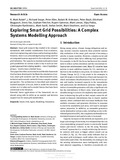JavaScript is disabled for your browser. Some features of this site may not work without it.
| dc.contributor.author | Rylatt, R. Mark | |
| dc.contributor.author | Snape, J. Richard | |
| dc.contributor.author | Allen, Peter M. | |
| dc.contributor.author | Ardestani, Babak M. | |
| dc.contributor.author | Boait, Ekkehard | |
| dc.contributor.author | Fan, Denis | |
| dc.contributor.author | Fletcher, Graham | |
| dc.contributor.author | Gammon, Rupert | |
| dc.contributor.author | Lemon, Mark | |
| dc.contributor.author | Pakka, Vijay | |
| dc.contributor.author | Rynikiewicz, Christophe | |
| dc.contributor.author | Savill, Mark A. | |
| dc.contributor.author | Smith, Stefan | |
| dc.contributor.author | Strathern, M. | |
| dc.contributor.author | Varga, Liz | |
| dc.date.accessioned | 2016-06-14T13:34:26Z | |
| dc.date.available | 2016-06-14T13:34:26Z | |
| dc.date.issued | 2015-08-26 | |
| dc.identifier.citation | Rylatt, R. M. (2015) Exploring smart grid possibilities: a complex systems modelling approach, Smart Grid, Vol. 1, Iss. 1 pp. 1-15 | en_UK |
| dc.identifier.issn | 2299-1107 | |
| dc.identifier.uri | http://dx.doi.org/1515/sgrid-2015-0001 | |
| dc.identifier.uri | https://dspace.lib.cranfield.ac.uk/handle/1826/9977 | |
| dc.description.abstract | Smart grid research has tended to be compartmentalised, with notable contributions from economics, electrical engineering and science and technology studies. However, there is an acknowledged and growing need for an integrated systems approach to the evaluation of smart grid initiatives. The capacity to simulate and explore smart grid possibilities on various scales is key to such an integrated approach but existing models – even if multidisciplinary – tend to have a limited focus. This paper describes an innovative and flexible framework that has been developed to facilitate the simulation of various smart grid scenarios and the interconnected social, technical and economic networks from a complex systems perspective. The architecture is described and related to realised examples of its use, both to model the electricity system as it is today and to model futures that have been envisioned in the literature. Potential future applications of the framework are explored, along with its utility as an analytic and decision support tool for smart grid stakeholders. | en_UK |
| dc.language.iso | en | en_UK |
| dc.publisher | De Gruyter Open | en_UK |
| dc.rights | Attribution-Non-Commercial-No Derivatives 3.0 Unported (CC BY-NC-ND 3.0). You are free to: Share — copy and redistribute the material in any medium or format. The licensor cannot revoke these freedoms as long as you follow the license terms. Under the following terms: Attribution — You must give appropriate credit, provide a link to the license, and indicate if changes were made. You may do so in any reasonable manner, but not in any way that suggests the licensor endorses you or your use. Information: Non-Commercial — You may not use the material for commercial purposes. No Derivatives — If you remix, transform, or build upon the material, you may not distribute the modified material. No additional restrictions — You may not apply legal terms or technological measures that legally restrict others from doing anything the license permits. | en_UK |
| dc.subject | Smart | en_UK |
| dc.subject | Grid | en_UK |
| dc.subject | Agent | en_UK |
| dc.subject | Modelling | en_UK |
| dc.subject | Simulation | en_UK |
| dc.title | Exploring smart grid possibilities: a complex systems modelling approach | en_UK |
| dc.type | Article | en_UK |
Files in this item
This item appears in the following Collection(s)
-
Staff publications (SATM) [4364]
